How CEOs Build Unshakeable Confidence in Their Leadership

As we brace for economic uncertainties and political instability, a significant concern among CEOs is their confidence in their leadership teams’ ability to navigate the anticipated economic uncertainties.
According to the 2023 EY January CEO Outlook Pulse survey, 53% of CEOs feel that few senior leaders possess the necessary experience to manage the upcoming economic volatility despite having gained critical skills during the COVID-19 pandemic. This gap in leadership competency and experience highlights the urgent need for CEOs to foster and build confidence within their leadership teams to ensure resilience and strategic decision-making in the face of the challenges expected in the coming years.
Confidence (important to distinguish this from overconfidence or arrogance) is more than just a trait; it’s a crucial mindset that distinguishes successful CEOs from the rest. A confident mindset is not about knowing everything or never failing—it’s about believing in one’s ability to learn, adapt, and lead effectively, even in the face of uncertainty. This mindset is pivotal for CEOs who need to inspire trust, make decisive decisions, and navigate their organizations through both calm and stormy waters.
In this blog post, we will discuss the concept of a confident mindset and explore its critical role in the CEO and the organization’s success.
Defining Confidence vs. Arrogance
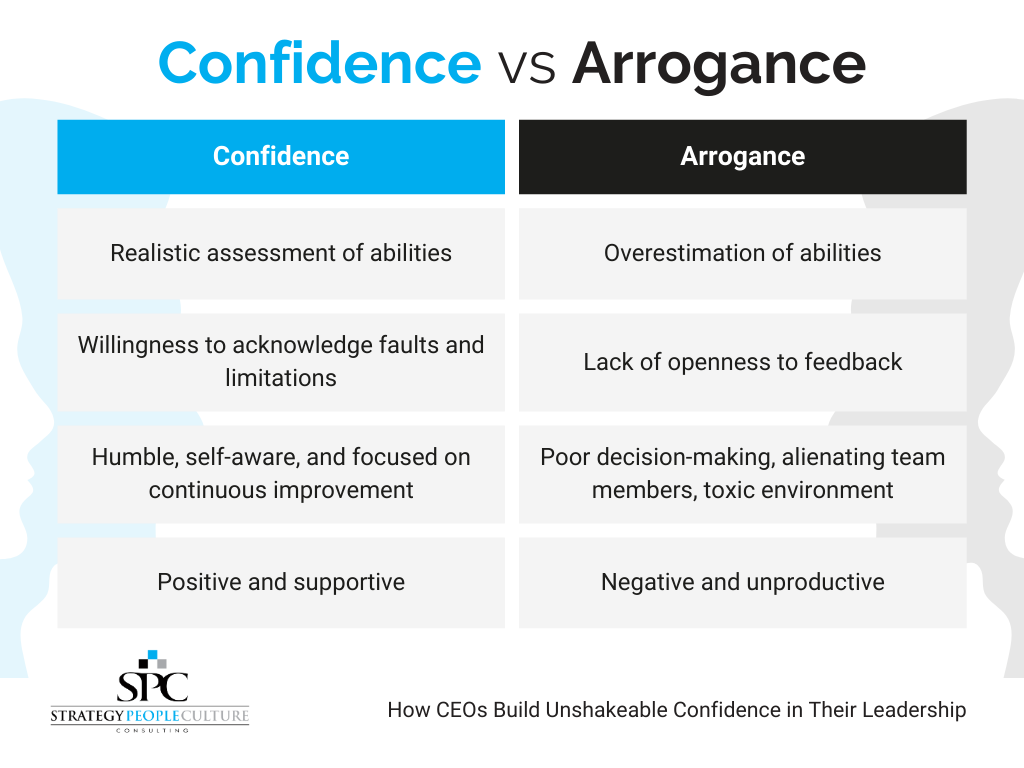
Confidence and arrogance are often mistaken for one another. Confidence involves a realistic sense of one’s abilities and a willingness to see honestly where one’s faults and lack of knowledge, skills, or abilities may be. In contrast, arrogance entails overestimating abilities and a lack of openness to feedback.
Arrogance can lead to poor decision-making, team member alienation, and a toxic work environment. In contrast, confident leaders are humble and self-aware, recognizing their strengths and weaknesses and continually striving for improvement.
“When the leader lacks confidence, the followers lack commitment.”
― John C. Maxwell
“The only thing more dangerous than ignorance is arrogance.”
— Albert Einstein
The 10 Pillars of the Confident Mindset
A confident CEO inspires trust, motivates the leadership team, and drives results. This confidence is not just about self-assurance but is built upon a foundation of key principles and practices. Here are some of the pillars that support a confident leader:
1. Self-Awareness
Confident leaders deeply understand their strengths, weaknesses, values, and motivations. They know how their emotions and behaviors impact others and can regulate themselves accordingly.
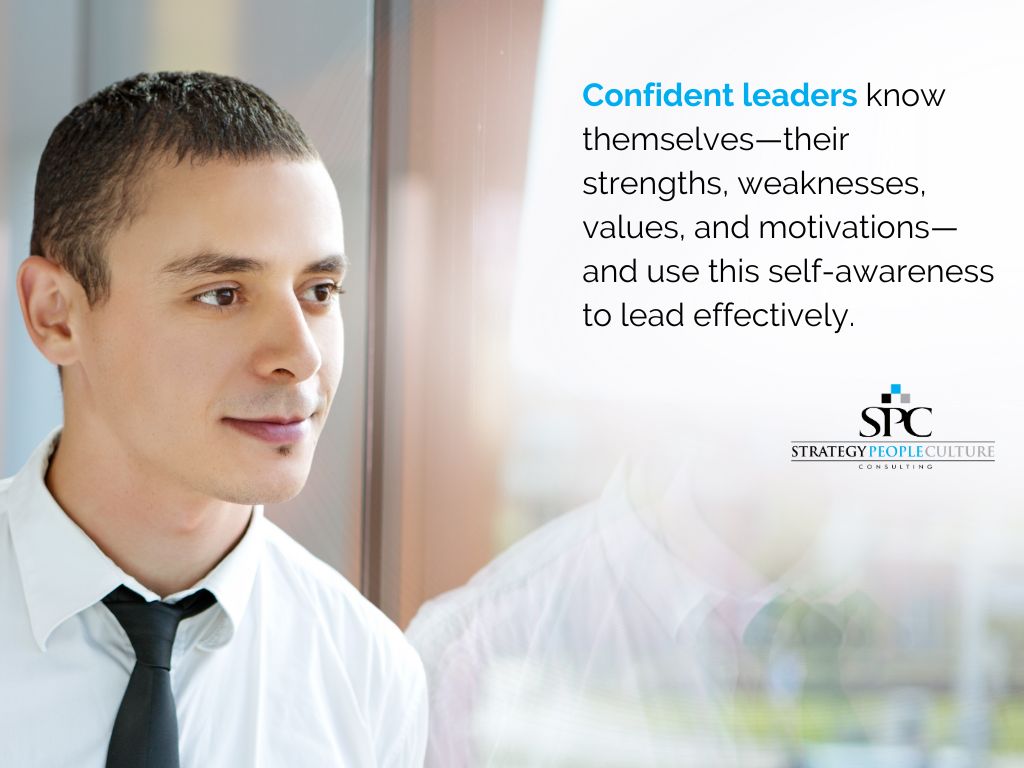
2. Resilience
Challenges and setbacks are inevitable. Confident leaders can bounce back from adversity, learn from their mistakes, and continue moving forward.
3. Growth Mindset
Confident leaders believe dedication and hard work can develop their abilities and intelligence. They embrace challenges, persist in the face of setbacks, and see effort as the path to mastery.
4. Vision
A clear vision provides direction and purpose for both the leader and the team. Confident leaders can articulate a compelling vision and inspire others to work towards it.

5. Strong Values
Confident leaders understand their moral compass and the line of their ethical standards. Their actions align with their values, and they make decisions based on what is consistent with these standards, even when difficult.
6. Decisiveness
Confident leaders are not afraid to make tough decisions. They gather information, weigh options, and then act decisively, even in the face of uncertainty.
7. Empowerment
Confident leaders trust their team and delegate responsibilities. They provide support and guidance but also allow others to take ownership and grow.

8. Communication
Open and transparent communication is essential for building trust and fostering collaboration. Confident leaders listen actively, share information clearly, and provide constructive feedback.
9. Humility
Despite their accomplishments, confident leaders remain humble. They recognize that they don’t have all the answers and are willing to learn from others.
10. Empathy
Confident leaders understand and connect with their team members’ emotions. They show compassion and create a supportive environment where everyone feels valued.
The Trust Factor
Trust and integrity are the foundations of confidence in leadership. Building trust within a team involves being transparent, consistent, and reliable.
Leaders can build trust by fostering open communication, encouraging collaboration, and demonstrating empathy. Trust leads to higher employee engagement and loyalty.
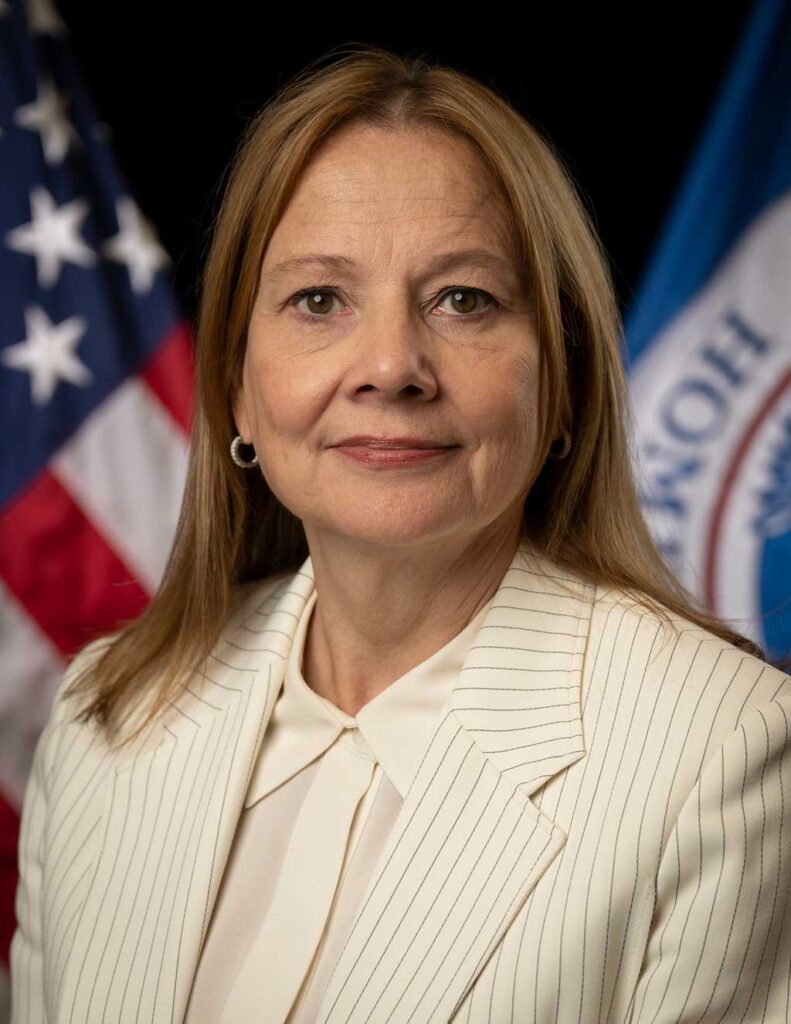
Mary Barra, CEO of General Motors (GM)
Mary Barra is a prime example of an executive who has fostered trust and confidence in leadership. When she became CEO in 2014, GM faced a major crisis due to a faulty ignition switch recall. Barra took immediate action, apologizing publicly, launching an internal investigation, and creating a compensation fund for victims.
How Barra built trust and confidence:
Transparency: Barra was open and honest about the company’s mistakes, taking responsibility for the issue and communicating regularly with stakeholders.
Accountability: She held herself and others accountable for the company’s actions, firing employees who were involved in covering up the faulty ignition switch.
Decisive action: Barra swiftly addressed the crisis, demonstrating her commitment to resolving the issue and preventing similar problems in the future.
Empathy: She showed genuine concern for the victims of the faulty ignition switch, meeting with them personally and offering compensation.
Visionary leadership: Barra outlined a clear vision for the company’s future, focusing on innovation, safety, and sustainability. She has led GM through a significant transformation, investing in electric vehicles, autonomous driving technology, and new mobility services.
Barra is widely respected by both employees and investors, and she is considered one of the most successful CEOs in the world.
The Culture of Accountability
A culture of accountability is the scaffold for robust leadership confidence. CEOs who embed accountability within their leadership teams affirm their expectations clearly, leading to heightened performance and harmony.
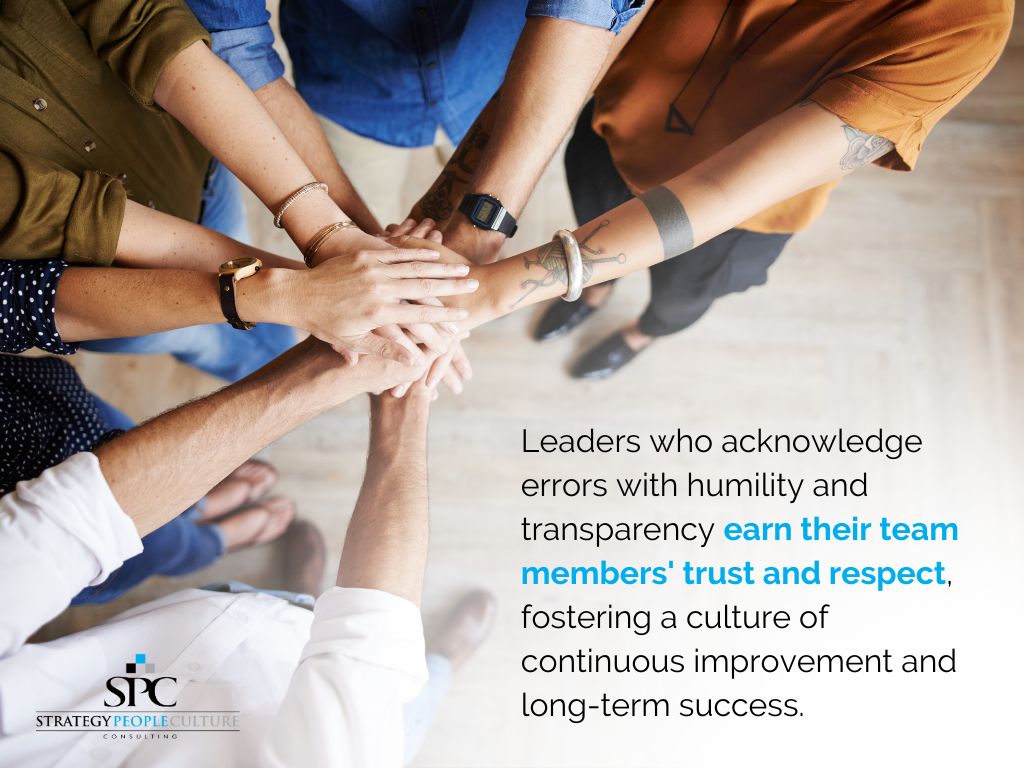
According to an article from the Atlanta Journal-Constitution, leadership accountability encompasses setting clear goals, following through on promises, and cultivating a culture of responsibility. Leaders who acknowledge errors with humility and transparency earn their team members’ trust and respect, fostering a culture of continuous improvement and long-term success.
Accountability is intertwined with responsibility, building a foundation that bolsters a leader’s confidence. Secure in the knowledge that each team member understands their role; leaders can focus on strategic objectives rather than micromanaging tasks.
Cultivating the Confident Mindset
As a CEO, your influence extends far beyond strategic decisions. Your leadership style directly impacts the confidence and effectiveness of your team. By actively fostering a culture of self-belief and resilience, you’ll unlock the full potential of your leadership team and drive exceptional results.
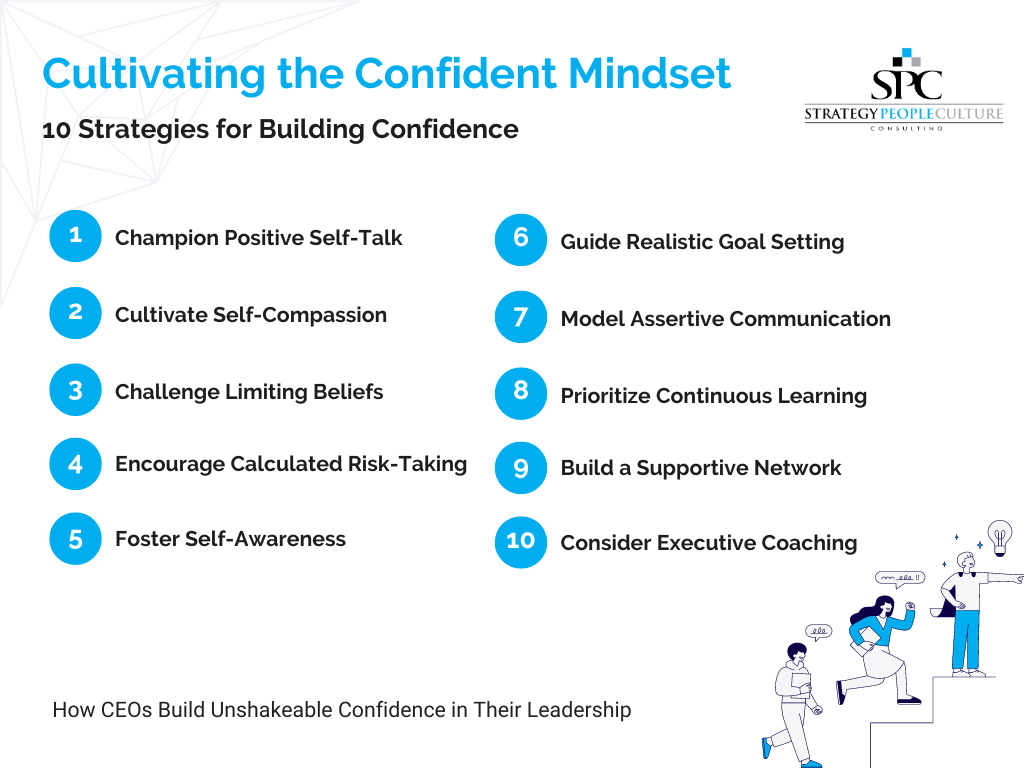
1. Champion Positive Self-Talk: Lead by example in sharing your own positive affirmations and model the power of constructive self-dialogue. Encourage team affirmations like “We are a resilient team capable of overcoming obstacles” and “We trust each other’s expertise and judgment.” Create a safe space for leaders to share challenges and reframe setbacks as learning opportunities, normalizing vulnerability.
2. Cultivate Self-Compassion: Promote mindfulness practices like meditation or short breaks for reflection to reduce stress and increase self-awareness. Emphasize that mistakes are part of growth and create a culture where learning from failure is valued, normalizing imperfection.
3. Challenge Limiting Beliefs: Facilitate group discussions or workshops where leaders can identify and reframe negative thoughts into empowering beliefs. Offer individual coaching to help leaders address personal limiting beliefs.
4. Encourage Calculated Risk-Taking: Create a safe environment for experimentation, allowing leaders to explore innovative ideas without fear of harsh repercussions for missteps. Publicly acknowledge and reward leaders who take calculated risks, even if the outcome isn’t perfect.
5. Foster Self-Awareness: Provide a structured process for leaders to receive 360-degree feedback from peers, direct reports, and you as the CEO. Encourage participation in leadership workshops, conferences, or self-assessment tools for personal development.
6. Guide Realistic Goal Setting: Ensure individual leadership goals align with and contribute to the overarching company objectives. Offer resources and mentorship to help leaders set SMART goals and track their progress.
7. Model Assertive Communication: Demonstrate clear and respectful communication, showing your leadership team how to express ideas confidently and listen actively to others. Invest in workshops or training sessions to enhance the team’s communication skills.
8. Prioritize Continuous Learning: Allocate resources for development and budget for leadership programs, conferences, or online courses to encourage ongoing growth. Create a culture where leaders share insights and lessons from their development experiences, encouraging knowledge sharing.
9. Build a Supportive Network: Facilitate peer mentoring, pairing leaders with different strengths to encourage mutual support and learning. Introduce external mentors, connecting leaders with experienced executives outside the company for broader perspectives.
10. Consider Executive Coaching: Partner with a reputable executive coaching firm to provide personalized guidance and support, investing in leadership development.
By actively implementing these strategies, you’ll cultivate a confident, resilient leadership team that can drive your organization to new heights.
Leading through Change

Adaptability and adept change management are the hallmarks of assured leadership. Leaders who navigate transitions smoothly ensure that their organizations thrive in dynamic environments. A leader’s confidence during these periods does not merely guide; it stabilizes and directs the collective energy toward organizational resilience and growth.
Conclusion
Building confidence within your leadership team is not just an investment in their individual growth but a strategic move that can significantly enhance your organization’s resilience and performance. As we’ve explored, empowering your leaders through fostering self-awareness, continuous learning, and a supportive environment can create a foundation of trust and confidence. Effective communication, resilience-building practices, and leveraging executive coaching are critical strategies that CEOs can implement to cultivate a confident and capable leadership team.
By focusing on these areas, you not only boost the morale and capabilities of your senior leaders but also ensure that your organization is better equipped to navigate challenges and seize opportunities. Don’t wait to transform your leadership dynamics — schedule your appointment today and start your journey toward building a more confident and successful team.
